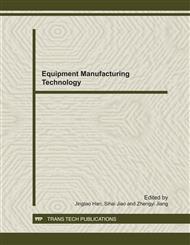p.228
p.233
p.238
p.243
p.250
p.257
p.262
p.268
p.276
Study on Integral-Separate PID Improved Predictive Control for Electro-Hydraulic Control System of Strip Steel CPC
Abstract:
As electro-hydraulic control system of strip steel CPC has some special characteristics, such as strong nonlinear, changes in structural parameters, serious time-delay and the very difficultly of establishing accurate mathematical model, the integral-separate PID improved predictive control algorithm was proposed on the basis of the new mathematical model. Firstly, the integral-separate PID algorithm was used to make system asymptotic stability and reduce overshoot of system. Secondly, the predictive control algorithm was proposed, error feedback correction model was improved, and predictive control signal was optimized with rolling method. Finally, the system was simulated and analyzed in noise and pulse disturbance. The simulation results show that this algorithm can effectively improved abilities of anti-noise and anti-load disturbance, increases robustness and tracking capability of strip steel CPC system; furthermore, it can improved speed of system response and decrease time-delay and overshoot of system. Therefore, this algorithm can well meet the need of electro-hydraulic control system for strip steel CPC system.
Info:
Periodical:
Pages:
250-256
Citation:
Online since:
December 2011
Authors:
Price:
Сopyright:
© 2012 Trans Tech Publications Ltd. All Rights Reserved
Share:
Citation:


